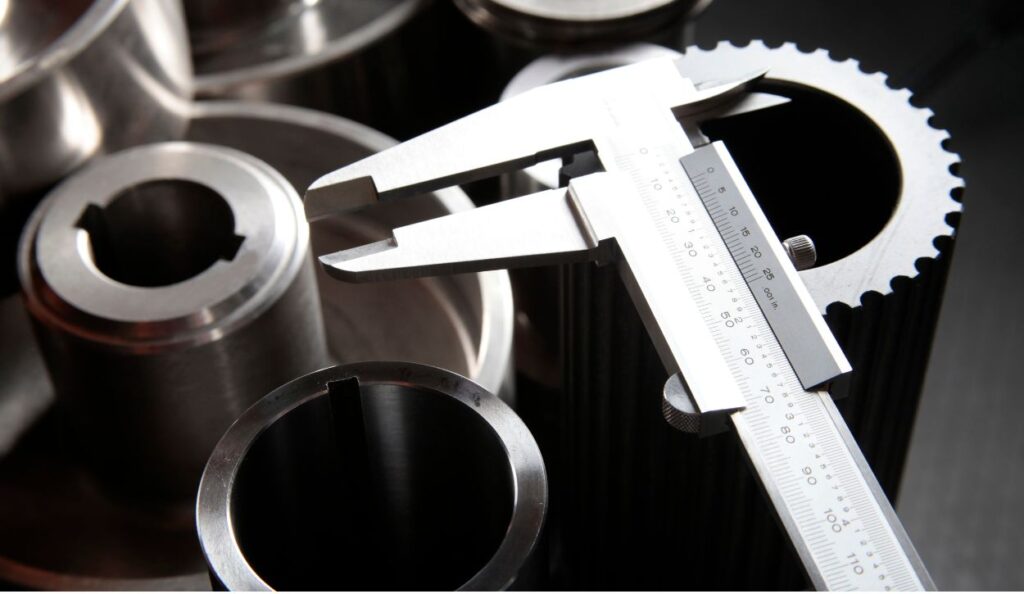In precision engineering, tight-tolerance machining is a cornerstone for manufacturing processes where accuracy is not just a requirement but the lifeblood of functionality and quality control. This technique ensures components fit together flawlessly, performing at peak levels for aerospace, medical devices, and automotive applications where the line between success and failure can be as fine as a human hair.
In this article, we will examine what tight-tolerance machining entails, why it’s essential, and how to achieve it with all machine tools and in every machine shop.
What Does Tight Tolerance Mean?
Tight tolerance machining is a manufacturing process in which precision parts are produced with precise measurements. In this context, ‘tolerance’ refers to the allowable limit of variation in a physical dimension, and ‘tight’ tolerance means that this variation is minimal, often down to a thousandth of an inch or less. This extreme precision is critical in industries where even the smallest deviation from product design specifications can significantly affect the product’s performance, safety, or functionality. Aerospace, medical, automotive, and military sectors often require tight-tolerance parts because they are integral to the safety and functionality of their products. Achieving such precision requires advanced machinery, skilled operators, and meticulous quality control. Failure to adhere to these rigorous standards can compromise the integrity of the final product, highlighting the importance of tight tolerance machining in high-stakes applications.
Why Are Tighter Tolerances Necessary?
Precision machining of components ensures they accurately reflect the intended design specifications. When tolerances are stringent, the performance and reliability of these parts are significantly improved.
Consider the aerospace and automotive sectors, where high-precision parts require very tight tolerances. They guarantee that components fit together perfectly and operate according to their part design.
In contrast, if tolerances are too generous, there is a risk of improper fitting which could severely affect performance and pose safety hazards.
Manufacturers can achieve repeatability in dimensions, shapes, and other critical factors by utilizing tight-tolerance CNC machining techniques. This precision is especially vital in the medical device industry where part accuracy is synonymous with patient safety and product effectiveness.
Beyond enhancing product integrity, a strict tolerance CNC machining process brings efficiency gains to the manufacturing workflow. High-precision CNC machines can produce parts faster while reducing material wastage, saving time, and cutting costs which directly benefits the client with speedier lead times and lower prices.
How Can Machinists Achieve Even the Tightest Tolerances?
Machinists must adopt a meticulous and systematic approach to achieve the tightest tolerances. Precision machined parts result from several factors, including the machinery’s quality, the machinist’s skill level, the material used, and the techniques applied.
Machinery Quality
CNC machines offer advanced capabilities suitable for complex parts, but many machine shops still rely on conventional manual machines. These machines must be well maintained and equipped with devices, such as digital readouts (DRO), for milling and drilling accurately on milling machines and lathes.
Tool Calibration
Regular tool calibration ensures optimal performance. Precise measuring instruments such as micrometers, gauges, and calipers can detect even the slightest deviations from the desired measurements specified during the design stage.
Material Selection
Understanding the properties of different materials is crucial, as they can expand or contract with temperature changes. Selecting the suitable material during the design phase can mitigate issues with tolerances on the workpiece.
Technique Refinement
Machinists should employ consistent workholding techniques to ensure stability during machining. Advanced techniques like ‘peck drilling’ or ‘climb milling’ can also produce more accurate results.
Environmental Control
Temperature fluctuations can affect both the material and machinery. Controlling the temperature and humidity is essential for minimizing thermal expansion and achieving high-quality machined parts.
Finally, continuous training and experience are invaluable. Machinists must stay informed about the latest cutting tools, techniques, and materials. By combining state-of-the-art equipment with honed skills and attention to detail, achieving tight tolerances is well within reach.
Is There a Downside to Maintaining Tight Tolerances?
While striving for tight tolerances in manufacturing ensures high levels of precision, it also introduces several challenges. The process typically demands sophisticated CNC machining services and highly skilled labor, which can significantly increase production costs. Close tolerances leave little room for error, resulting in a higher scrap rate or the need for costly rework when products deviate from the stringent standards. Additionally, the time-intensive nature of producing parts with tight tolerances can slow down the production process, potentially disrupting supply chains and market responsiveness.
Additionally, maintaining tight tolerances can limit the choice of materials since not all materials can withstand the processing required for high-precision manufacturing. In some scenarios, such intense focus on precision might be over-engineered during the design process for the product’s intended use, thus unnecessarily inflating expenses without providing proportional value to the end-user. This overemphasis on accuracy can create an imbalance, sacrificing cost-effectiveness and flexibility for marginal gains in product performance.
CNC Machining is Essential for Tight Tolerances
Tight tolerance machining benefits industries that require high levels of accuracy and consistency. Although it presents challenges such as higher costs, longer production times, and the need for advanced equipment and skilled operators, its advantages to complex and high-specification projects typically outweigh these drawbacks. It empowers manufacturers to produce parts with exceptional reliability and performance, which is indispensable in critical applications like aerospace, medical devices, and automotive manufacturing. Therefore, when precision is paramount, tight tolerance machining is beneficial and often essential.
CNC machining is appreciated for its versatility and application in both large-scale and small-scale manufacturing. Learn more in our Guide to CNC Machines or contact our team with any questions you have.














































































